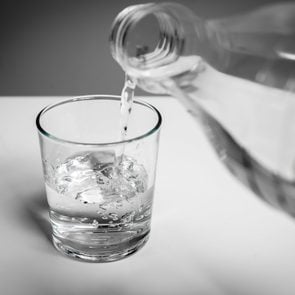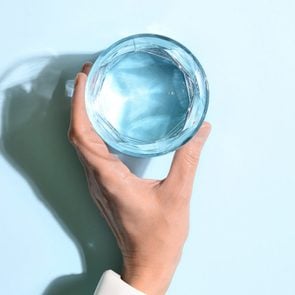Which Type of Water Is Right for You? Here’s How to Choose
Updated: Aug. 04, 2022
The types of water on grocery store shelves are multiplying, from bottled to mineral to coconut and more. Which ones are best? Check out what the experts have to say.
On This Page
Water: Decoding the different types
Water is not just water anymore. Grocery shelves are packed with a dizzying array of choices, from plain to flavored, mineral to coconut to vitamin-infused.
It’s essential for all cells, organs, and tissues. “It regulates body temperature, breaks down food and nutrients, aids in digestion, flushes out toxins, and circulates oxygen to the brain,” says Ashley Baumohl, RD, assistant clinical nutrition manager at Lenox Hill Hospital in New York City.
(Here are more reasons to drink water.)
Recommendations vary, but most experts agree the average person should drink six to eight 8-ounce glasses of water a day. You may need more or less—it’s all contingent on your overall health and whether you have any medical conditions or take medications, among other variables.
Here’s everything you need to know about the 10 types of water, all of which can contribute to your daily fluid intake, says Baumohl.
Tap water
Most Americans have access to drinkable tap water, but this “can come from a variety of sources, such as wells or reservoirs,” says Amanda Beaver, RDN, wellness dietitian at Houston Methodist Wellness Services. The Environmental Protection Agency (EPA) sets standards for public water systems, while owners of private wells have to do their own testing.
The pros
- Tap water is usually safe and convenient, regardless of its source, and most cities and towns add fluoride, which cuts down on cavities and tooth decay, says Beaver.
- It’s better for the environment because it doesn’t require single-use plastic bottles.
- Tap water is cheap.
- It contains minerals like calcium, magnesium, potassium, bicarbonate, and silica.
The cons
- Some communities have unacceptable levels of contaminants—remember Flint, Michigan, where the water had unacceptably high levels of lead for half a decade.
- If there are agricultural or manufacturing practices nearby, some communities may face higher levels of pollutants or bacteria, adds Beaver.
- If there’s a natural disaster, like a hurricane or the extreme cold recently seen in Texas and elsewhere, the water from your tap could become unsafe or nonexistent.
- Some people don’t like the taste of tap water, although that can often be fixed with a water filter, says Beaver.
Bottled water
This is where we get into the many, many choices. Depending on the brand, bottled water can come from springs, wells, and surface waters. Sometimes it’s just tap water with something added, like minerals. The Food and Drug Administration (FDA) regulates bottled water as a food. It doesn’t require manufacturers to test it independently.
The pros
- Some people like the taste of bottled water better than that of tap water.
- It’s helpful, even essential, in natural disasters. In fact, the Centers for Disease Control and Prevention (CDC) recommends you have one gallon per person for three days—plus extra for pets—stored at all times. (Here’s more on the things to have in your home emergency kit.)
The cons
- One of the biggest downsides is the environmental impact. Less than a third of plastic bottles are recycled, according to the EPA. The rest end up in landfills or in the Pacific Ocean and other natural treasures.
- Plastic bottles may contain microplastics, which Beaver says contain chemicals called endocrine disruptors that interfere with the body’s hormones (the endocrine system). These chemicals, the most well-known bisphenol A (BPA), can accumulate in the organs over time.
- Glacier water is bottled water that may come from a glacier—or not. “It may come from springs or wells,” says Beaver. “My advice is to skip the ‘glacier water’ and its expensive price tag.”
(Here are some facts that will make you stop using plastic.)
Purified water
“This is simply tap water that has been filtered to remove impurities like metals, chemical pollutants, and fungi to make the water as pure as possible,” explains Baumohl. “In most Westernized countries, public drinking water is purified to make it safe for human consumption.”
Most bottled water is also purified, adds Beaver.
The pros
- If you’re getting it from your tap, it’s safe, easy, cheap, and environmentally friendly.
- You can purify your own water with water filtration systems, says Beaver.
The cons
- Purified water from bottles is a drain on the environment.
- It costs money.
- Microplastics in bottled water may pose health threats. “I don’t recommend my clients use single-use plastic water bottles that have sat in the car a long time or use them over and over again,” says Beaver. “Use once or opt for reusable bottles made of glass or stainless steel and fill with tap or filtered water.”
Distilled water
This is water that has been boiled, the steam trapped, then condensed back into water.
The pros
- The distillation process leaves behind almost all of the water’s mineral content and kills any bacteria or viruses, says Beaver.
- The small amounts of minerals, like magnesium and calcium, may be beneficial for our health, Beaver says.
- It’s the preferred water for sinus irrigation methods, like Neti pots.
The cons
- It usually comes in plastic containers that may end up polluting the environment.
- Microplastics in bottled water may pose health threats.
Mineral water
Mineral water is another type of bottled water. “Water bottles labeled this way must have a certain amount of naturally occurring minerals and cannot have any minerals added,” says Beaver. “It also must come from a protected underground water source.”
The pros
- The minerals may be good for your health.
The cons
- It comes in a container, adding to potential environmental pollution.
- It can be pricey.
- It might contain microplastics that may harm your health.
Alkaline water
This water is less acidic than regular water. “Pure water has a pH of 7, so any water that has a pH higher than that is considered to be alkaline,” says Baumohl. The pH scale, a measure of how acidic something is, runs from 0 to 14, with 0 being the most acidic and 14 being the most alkaline.
The pros
- Proponents of alkaline water say it neutralizes the acid in your body, which may benefit conditions like acid reflux, but this is far from certain. In a study published in Annals of Otology, Rhinology & Laryngology, researchers examined alkaline water’s effect on a stomach enzyme that plays a role in acid reflux. Though the water showed promise with alleviating acid reflux, it was done in the lab and did not involve either animals or humans. This type of study is very preliminary, and there’s a lot of additional research needed before researchers can say for sure whether alkaline water is beneficial.
- Alkaline environments may inhibit bacteria. This theory is flawed though, as acids often kill bacteria.
The cons
- Your body does a good job of maintaining the right pH all by itself, so alkaline water may be a waste of money.
- If you drink a gallon or more every day, you may reduce the amount of stomach acid in your body.
Sparkling water
This water includes added carbonation. It is more acidic than regular water, but it doesn’t make your body more acidic.
The pros
- It’s definitely healthier than soda or juice, and may be helpful in weaning you off sodas.
- You can make it yourself.
- Sparkling mineral water contains calcium, which is good for your bones.
The cons
- The acidic pH may contribute to tooth decay compared with regular water, says Beaver. The addition of citric acid and natural flavors may lower the pH even more, potentially damaging tooth enamel. The risk is probably minimal, and both are much better than sugar-sweetened beverages, says Beaver.
- Some varieties (like tonic water) contain sugar. So choose carefully, making sure sparking water or club soda have no added sugars. Also, make sure the sodium content is low.
- Any carbonated drink can aggravate acid reflux.
- The cost can add up.
Flavored water
This is water, sparkling or otherwise, with added flavor and, says Beaver, sometimes caffeine.
The pros
- Typically these drinks have fewer calories than sodas, something which can help with weight loss or maintenance.
- Like sparkling water, it can help you transition from sodas, juice, and other high-sugar beverages.
The cons
- It may contain caffeine or excess sodium.
- It comes in containers with potentially health-harming microplastics.
- The bottles can add to environmental pollution.
- It’s not free and may cost more money than regular bottled water.
Vitamin water
Add vitamins to flavored water and you have vitamin water.
The pros
- There are zero-calorie versions of vitamin water, sweetened with stevia, sorbitol, and other artificial sweeteners.
The cons
- Regular vitamin water is sweetened with sugar. One bottle can contain 26 grams or more of added sugar, which is more than the American Heart Association recommends for women in one day, says Beaver.
- While vitamins are good, they’re better when they come from food, including hydrating foods. “You can get vitamin C packaged with fiber and antioxidants from hydrating fruits and veggies like strawberries, red bell peppers, and oranges,” says Beaver.
- It costs money.
- It comes in a container, which may add to environmental damage.
- Its plastic bottle may contain microplastics that might damage your health.
Coconut water
A clear liquid sourced from green coconuts, coconut water is an alternative to regular water that comes with electrolytes—essential minerals used in many bodily processes—and a distinctive flavor.
The pros
- With fewer calories and added sugar, it’s healthier than soda or fruit juice.
- It contains fluids, sugars, and electrolytes which, says Baumohl, “are the main components needed for adequate hydration after high-level exercise.”
The cons
- It has less sodium and carbs than mainstream sports beverages so won’t be as helpful in replenishing and rehydrating your body after a heavy workout, says Baumohl.
- If one bottle contains more than one serving, you may be getting more sugar than you bargained for, says the Academy of Nutrition and Dietetics. Always check the label.
- It doesn’t hydrate you any better than regular water.
- Contrary to claims, it doesn’t help turn back the clock on aging.
- It can be expensive.
- The containers for bottled varieties will add to landfills and pollution.
The last word
Most people have their preference for the type of water they like to drink, and while some may contain higher or lower calories and sugar than others, they’re overall pretty much on par. Remember, make sure your water is free of any contaminants, such as fuel or toxic chemicals, before you drink it. Lastly, listen to your body and pay attention to when it’s dehydrated. Hydration is important, no matter which water you choose.
Next, here are the most hydrating foods to eat, without drinking water.



















